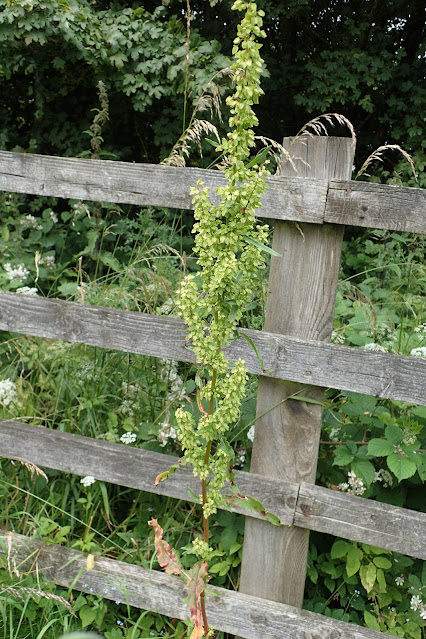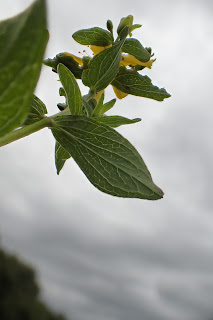On Sat 6 July the Yorkshire Naturalists' Union held their VC65 Field Meeting at Preston under Scar:

The weather, though breezy and not warm came out sunny in the afternoon - much better than the forecast, even warm enough in sheltered places to tempt a few butterflies. The rock is limestone ("acid limestone" - much less basic than in other places near Settle)
We visited the disused quarry and later the woodland and wooded over mineral vein workings and "Condenser house". Our base was at 270m above sea level (the river Ure 1.5 miles south is 120m, Preston Moor 2miles away north rises to 400m)
The moths people had emptied their traps and found over 70 species.
This is the quarry - with an amazing covering of Garden Lady' Mantle - Alchemilla mollis. The rabbits do not like it.
It could do with some vigorous weeding. If it doubles in quantity each year in three years the quarry will be full and overflowing.
We did find three native species (see lower down)

It might have looked good for Bee orchids but we did not find any. In the shade of wooded areas we found a very few Common Spotted orchids.
Snails: Terry O Conner went of looking for snails and came back with several including the
 |
| Pyramidula umbilicata (formerly P rupestris or P pusilla) - rock snail, found under rocks and under stones in stone walls |
 |
| Pyramidula umbilicata close up -(formerly P rupestris or P pusilla) - rock snail, found under rocks and under stones in stone walls |
 |
| The Lapidary snail has lens-shaped shell with a clearly visible keel. Helicigona lapicida |
found by Derek Whitely
I was pleased to find plenty of Heath snail. (I have found this in the Burren, at Lower Winskill, at the slope high above Stackhouse but I am told it has disappeared though much of Yorkshire except at the Coast.
I was informed today that this is an annual snail - so it must overwinter as eggs. Also it must grow quickly to get to this size.
We found lots of Heath snail shell one New Year's Day Plant Hunt in 2017 - at the liimestone cliff slope at the top of Bucker Brow, Settle. And indeed David Fisher who was with us in 2017 was here today too!
- I was concerned then that we were just finding dead Heath snails - but now can see why.
 |
| Helicella itala - Heath snail |
 |
Helicella itala - Heath snail
this one was sitting on top of Cladonia rangiformis. |
Distribution of Heath Snail
Flowers
Ian, Stella and I wandered round looking at flowers and Ian made a list which he will give to Linda Robinson the Plant recorder for VC65.
 |
Stork's-bill - Erodium cicutarium
|
We enjoyed finding Stork's-bill. This does not grow at Settle. It is a southern lowland plant, and this far north I usually only see i near the sea.
We did find Dove's-foot Crane's-bill, Meadow Crane's-bill and Cut-leaved Crane's-bill
 |
| Dove's-foot Crane's-bill |
 |
| Hoverfly on Hogweed |
 |
| Waxcap - but which one? Did smell a bit of honey but does not look like honey waxcap. |
Back to the Alchemillas
Here is a giant A mollis ready to gobble up space over the tiny Alchemilla glaucescens (I think)
 |
| Alchemilla glaucescens closer up. It has appressed velvety hairs on the back of its leaves and is small and likes to grow by footpaths (which is was doing) |
 |
| This one might be Alchemilla xanthochlora |
We also found A filicaulis and a possible A glabra.
This is a tiny Limestone Dandelion - I am hoping someone can tell me what species or at least group it is.
It is a bit like the one I found on a limestone mound on Malham Lings in that there are a few reflexed involucral bracts at the bottom of the involucre - but the Malham yellow ray florets were much narrowerer - and present in May.
--------------------
Elsewhere Alister and others were finding Good King Henry, Water forget-me-not, Brooklime, Typha latifolia and various Hypericums.
At the roadside near the main entrance to the quarry (gate firmly locked) was a Crepis (Hawk's-beard)
We agonised over this for a while, but have decided it is Crepis capillaris (This is much more common over nearly all of UK. C biennis is rarer and southern)).
(Note Hieraciums have hairs on some/most parts, and the phyllaries (involucral bracts - green scales round the outside of the flowerhead) are graduated between innermost and outermost. Crepis are glabrous except for the phyllaries and the phyllaries are in distinct inner and outer rows)
It would be useful to go back and measure the length of the achenes - 1.4-2.5 in C capillaris, 4-7.5mm in biennis.
We
I learned from Stella that Nodding Thistle/Musk Thistle Carduus nutans has a strong perfumy smell. Yes. It has!Later we tried Creeping thistle and that has a smell too.
Ian, Stella and I attempted to find the waterfall that others had talked about. We waded through bracken and long vegetation growing in the newly planted plantation and looked down on a waterfall not far from the road. But decided perhaps there was another one that the others had been talking about.
We enjoyed tea with the others at Preston under Scar Village Hall and discussed out findings.After tea Ian, Stella and I returned to the site and walked down to the "Condenser House" workings area. There was Luzula sylvatica and Carex remota (Remote Sedge) and Bromopsis ramosa (Hairy Brome), and a bank of Devil's bit Scabious. It would be good if some trees could be cleared to make more glades in the wood. I presume all the trees have gown over the last hundred or more years since the working were in operation.
 |
| Carex remota |
Lichens and Mosses.
The Lichens were not exceptional. We are quite a long way east so there were no species that need moist woodland. There was rather too much shade in the woodland, to allow may lichens to grow, and I did not see any very old trees.. I found one Peltigera (probably hymenina) on the footpath in the quarry.
Mosses: I did not notice any exceptional mosses. However here are three pictures of some strong growth of three species. I suspect the wet spring has encouraged them: Rhytidiadelphus triquetrous,
Trying to cover too many groups at once!!.
 |
| Rhytidiadelphus triquetrous |
Birds: We saw two kites circling over head and a peregrine shot past. A chiff chaff serenaded us in the wood.





















































